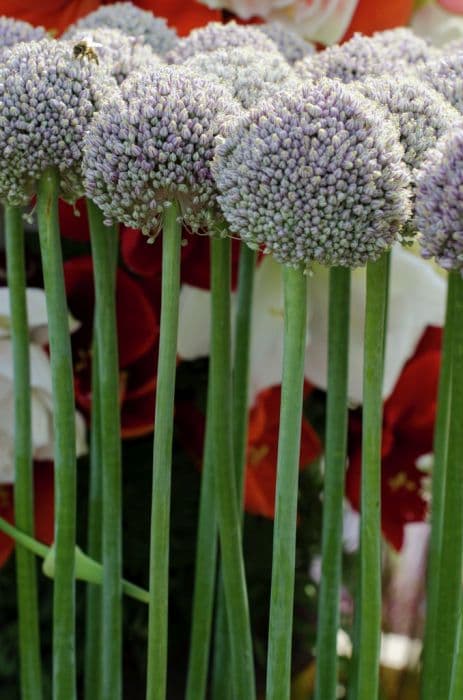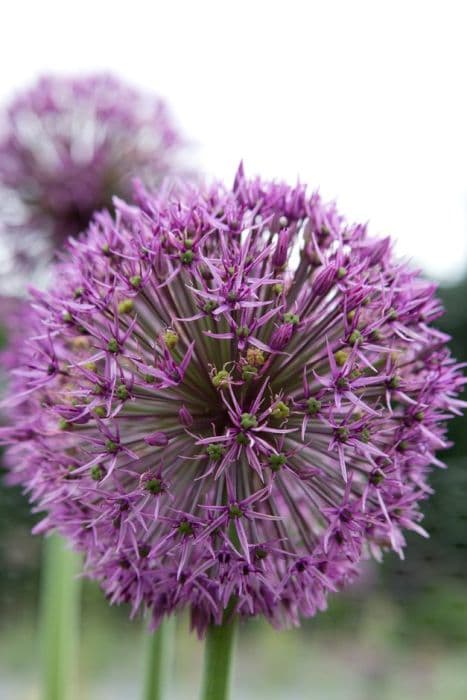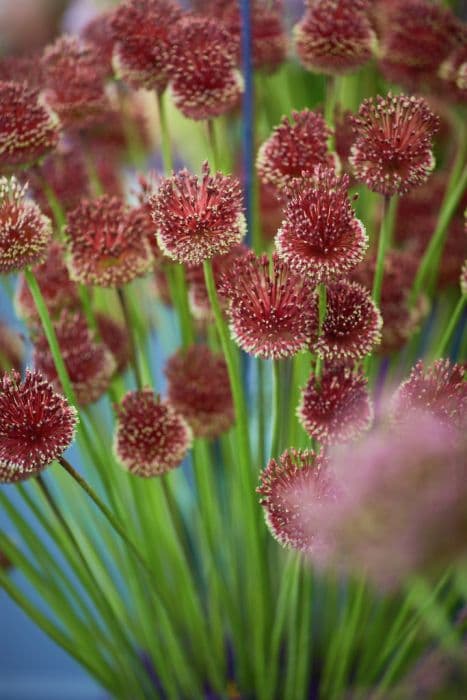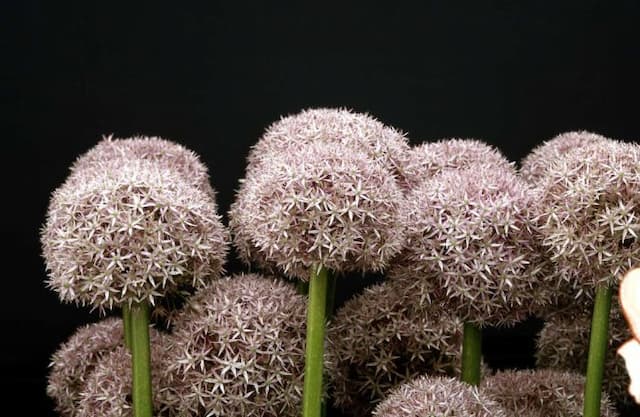Karataviense onion Allium karataviense
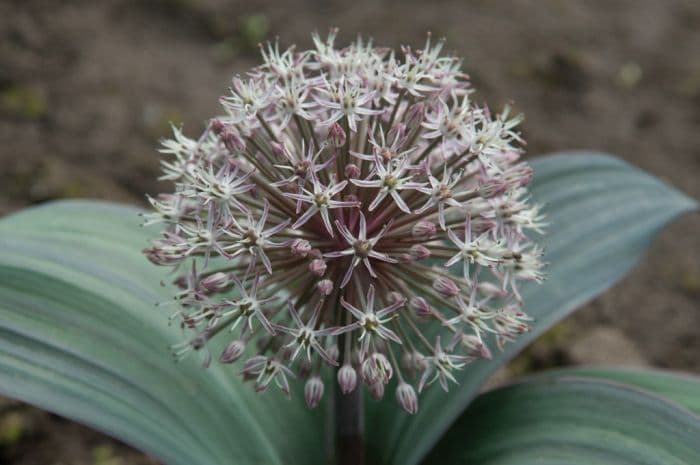
ABOUT
Allium karataviense, commonly known as the Turkestan onion, showcases a unique and ornamental appearance that adds interest to gardens and landscapes. This intriguing plant produces large, broad, and slightly arching leaves that are endowed with a luscious gray-green hue, often with a slight blue or purple tint, which provides a striking contrast to the more common greens found in a garden. The foliage is fleshy and can have interesting textures that catch the eye. What truly sets the Turkestan onion apart are its flowers. It boasts globular flower heads that can be described as dense umbels. These spherical bouquets sit atop sturdy, short stems, giving the impression of a floral ornament nestled within the foliage. The flowers themselves are typically a shade of pink, ranging from a soft, pastel pink to a more robust rosy hue. Each rounded cluster is an intricate assembly of numerous star-shaped flowers that combine to form an almost geometric display. As the plant matures, the allure does not fade. The flowers transform into attractive seed heads, extending the visual interest of the Turkestan onion well beyond its blooming period. These seed heads maintain the spherical shape and offer a textural contrast to the other elements in the garden. The overall appearance of Allium karataviense is one of robust beauty with a structural form that appeals not only to human admirers but also serves to attract pollinators such as bees and butterflies. This plant's distinctive look, with its lush leaves and enchanting flower heads, has cemented its popularity among gardeners looking for a low-lying feature that delivers high visual impact.
About this plant
 Names
NamesFamily
Amaryllidaceae
Synonyms
Karataviense Onion, Turkestan Onion, Karataviense Garlic
Common names
Allium karataviense.
 Toxicity
ToxicityTo humans
The plant commonly known as the Turkestan onion (Allium karataviense) is not generally considered toxic to humans. However, members of the Allium family can cause gastrointestinal irritation if ingested in large quantities. Symptoms can include stomach pain, nausea, vomiting, and diarrhea. It is always advisable to be cautious and avoid eating plants that are not specifically grown or recognized as food products.
To pets
The Turkestan onion (Allium karataviense) is toxic to pets, especially cats and dogs. Like other members of the Allium family, it contains compounds that can cause oxidative damage to red blood cells, leading to hemolytic anemia. Symptoms of poisoning may include lethargy, weakness, reduced appetite, pale gums, increased heart rate, increased respiratory rate, abdominal pain, vomiting, and diarrhea. If a pet ingests this plant, it is important to seek veterinary care immediately.
 Characteristics
CharacteristicsLife cycle
Perennials
Foliage type
Deciduous
Color of leaves
Blue-green
Flower color
Pink
Height
8-12 inches (20-30 cm)
Spread
8-12 inches (20-30 cm)
Plant type
Bulb
Hardiness zones
4-9
Native area
Central Asia
Benefits
 General Benefits
General Benefits- Aesthetic Appeal: Allium karataviense, commonly known as Turkestan onion, brings ornamental value to gardens with its attractive foliage and spherical flower heads.
- Low Maintenance: This plant is known for being drought-tolerant and requiring minimal care, making it a convenient choice for gardeners of all skill levels.
- Pollinator-Friendly: The flowers of the Turkestan onion attract bees, butterflies, and other pollinators, contributing to the health of the local ecosystem.
- Deer and Rodent Resistant: Its natural compounds make it unappealing to deer and rodents, protecting it from grazing and burrowing animals.
- Non-Invasive: Turkestan onion tends to grow within its space and does not aggressively spread, making it a good choice for controlled garden designs.
- Seasonal Interest: The plant offers visual interest throughout different seasons with its changing foliage and blooms.
- Easy to Propagate: It can be easily propagated through division, allowing gardeners to expand their plantings without additional costs.
- Edible Uses: While not its primary benefit, parts of the plant may be edible, adding a unique flavor to culinary dishes.
- Drought Tolerance: Once established, Allium karataviense can tolerate periods of dryness, ideal for xeriscaping and water-conservative gardens.
- Versatile Landscape Use: It can be used in rock gardens, borders, or as container plants, offering versatile landscaping options.
 Medical Properties
Medical PropertiesThis plant is not used for medical purposes.
 Air-purifying Qualities
Air-purifying QualitiesThis plant is not specifically known for air purifying qualities.
 Other Uses
Other Uses- Ornamental Value: Allium karataviense, known as Turkestan onion, is often grown for its attractive foliage and large, globe-shaped flower heads that add aesthetic value to gardens and landscaping.
- Floral Arrangements: The dried flower heads of the Turkestan onion are used in floral arrangements, adding structure and interest to bouquets and indoor displays.
- Garden Borders: Due to its low-growing nature, the Turkestan onion is suitable for planting at the front of garden borders or along walkways.
- Rock Gardens: Its tolerance for dry conditions makes Allium karataviense an excellent choice for rock gardens, where it can thrive in the well-draining soil.
- Companion Planting: Gardeners use the Turkestan onion as a companion plant to deter aphids and other pests from more susceptible plants with its natural repellent properties.
- Photography Prop: Its striking flowers make Allium karataviense a popular subject for floral and garden photography, admired for its unique globe-shaped inflorescence.
- Educational Tool: Botany students and enthusiasts grow Turkestan onion to study monocot characteristics and bulb development as part of their horticultural education.
- Pollinator Attraction: The flowers of the Turkestan onion attract bees, butterflies, and other pollinators, contributing to the health of the surrounding ecosystem.
- Culinary Display: Although not commonly used in cooking, the attractive nature of Allium karataviense flowers can be utilized as a decorative garnish on food platters and as part of edible landscaping practices.
- Theme Gardens: Gardeners interested in central Asian flora use the Turkestan onion to create geographical or international theme gardens representing the plant's native range.
Interesting Facts
 Feng Shui
Feng ShuiThe Allium karataviense, commonly known as Turkestan onion, is not used in Feng Shui practice.
 Zodiac Sign Compitability
Zodiac Sign CompitabilityThe Turkestan onion is not used in astrology practice.
 Plant Symbolism
Plant Symbolism- Perseverance - This plant, also known as Turkestan onion, often blooms through harsh conditions, representing the ability to press on through challenges.
- Strength - With its sturdy stems and robust blooms, the Turkestan onion symbolizes inner strength and resilience.
- Prosperity - In some cultures, the round bulbous shape of the Turkestan onion is reminiscent of wealth and abundance, making it a symbol of prosperity.
- Unity - As Alliums typically grow in clusters with multiple blooms forming a spherical shape, they can represent unity and togetherness.
- Protection - Historically, alliums, including the Turkestan onion, have been thought to ward off evil spirits and disease, symbolizing protection and safety.
- Healing - Given the medicinal properties of many allium species, Turkestan onion could also be associated with healing and good health.
 Water
WaterFor the Turkestan onion, also known as Allium karataviense, watering should be done carefully to avoid over-saturation, as the plant is drought-tolerant and excessive water can lead to rot. During the growing season, water the plant when the top inch of soil feels dry. Typically, this might happen once every week, but always check the soil first. When watering, aim to wet the soil evenly using about one or two gallons depending on the size of the plant and the dryness of the soil without allowing water to pool around the base. During the dormant period in winter, reduce watering significantly to reflect the plant's reduced needs.
 Light
LightTurkestan onions prefer full sun to partial shade conditions. The ideal spot for them is a location that receives at least six hours of direct sunlight each day. However, in particularly hot climates, some afternoon shade can help prevent scorching. Avoid deeply shaded areas where the plant would struggle to thrive.
 Temperature
TemperatureThe Turkestan onion thrives in a temperature range that mirrors its native mountainous habitat. It generally prefers temperatures between 50°F and 75°F but can survive short periods outside this range. The minimum temperature it can withstand is around 20°F, above which it may go dormant during the winter, and it can handle summer temperatures up to about 80°F before it starts to show signs of stress.
 Pruning
PruningPruning of the Turkestan onion is generally focused on aesthetic maintenance and removal of spent flower stems to encourage healthy growth and possibly more blooms in the next season. After flowering, cut back the flower stalks to ground level. Pruning is not frequently necessary for this plant but doing this clean-up once a year, typically after the blooming period, will help to keep the plant looking tidy.
 Cleaning
CleaningNot needed
 Soil
SoilThe best soil mix for Turkestan onion (Allium karataviense) should be well-draining with a mix of loam, sand, and compost. A soil pH of 6.0 to 8.0 is ideal for this plant.
 Repotting
RepottingTurkestan onion does not need to be repotted frequently. It's typically done every 3-4 years or when it's evident that the bulbs have outgrown their current space.
 Humidity & Misting
Humidity & MistingTurkestan onion thrives in average outdoor humidity levels, without the need for any special humidity adjustments.
 Suitable locations
Suitable locationsIndoor
Place in bright light, and keep soil moderately dry.
Outdoor
Plant in full sun to partial shade with good drainage.
Hardiness zone
4-9 USDA
 Life cycle
Life cycleAllium karataviense, commonly known as Turkestan onion, begins its life cycle with germination from a bulb, which typically occurs in early spring. Following germination, the plant develops a rosette of wide, broad leaves that are grayish-green in color. By late spring or early summer, the Turkestan onion produces sturdy stems topped with large globular flower heads of pink or white star-shaped flowers, which attract pollinators such as bees. After flowering, the plant sets seed, and the flower heads may turn into attractive dry structures that persist into autumn. With the approach of colder temperatures, the foliage of Allium karataviense dies back, and the plant enters dormancy, with the bulb surviving underground through the winter months. The cycle recommences the following spring, with the bulb sending out new growth once suitable conditions return.
 Propogation
PropogationPropogation time
Spring to early summer
The most popular method of propagating the Turkestan onion, also known as Allium karataviense, is by dividing the bulbs. This is typically done in the fall, after the leaves have died back, or in early spring before new growth begins. To propagate by division, gently lift the clump of bulbs from the soil using a garden fork, taking care not to damage them. Once lifted, the clump can be broken apart by hand into individual bulbs, each of which can be replanted. When replanting, ensure that the bulbs are set at a depth of approximately 3 inches (7.6 centimeters), and spaced 6 to 8 inches (15.2 to 20.3 centimeters) apart to give them enough room to grow. Water the bulbs well after planting to help establish them.
